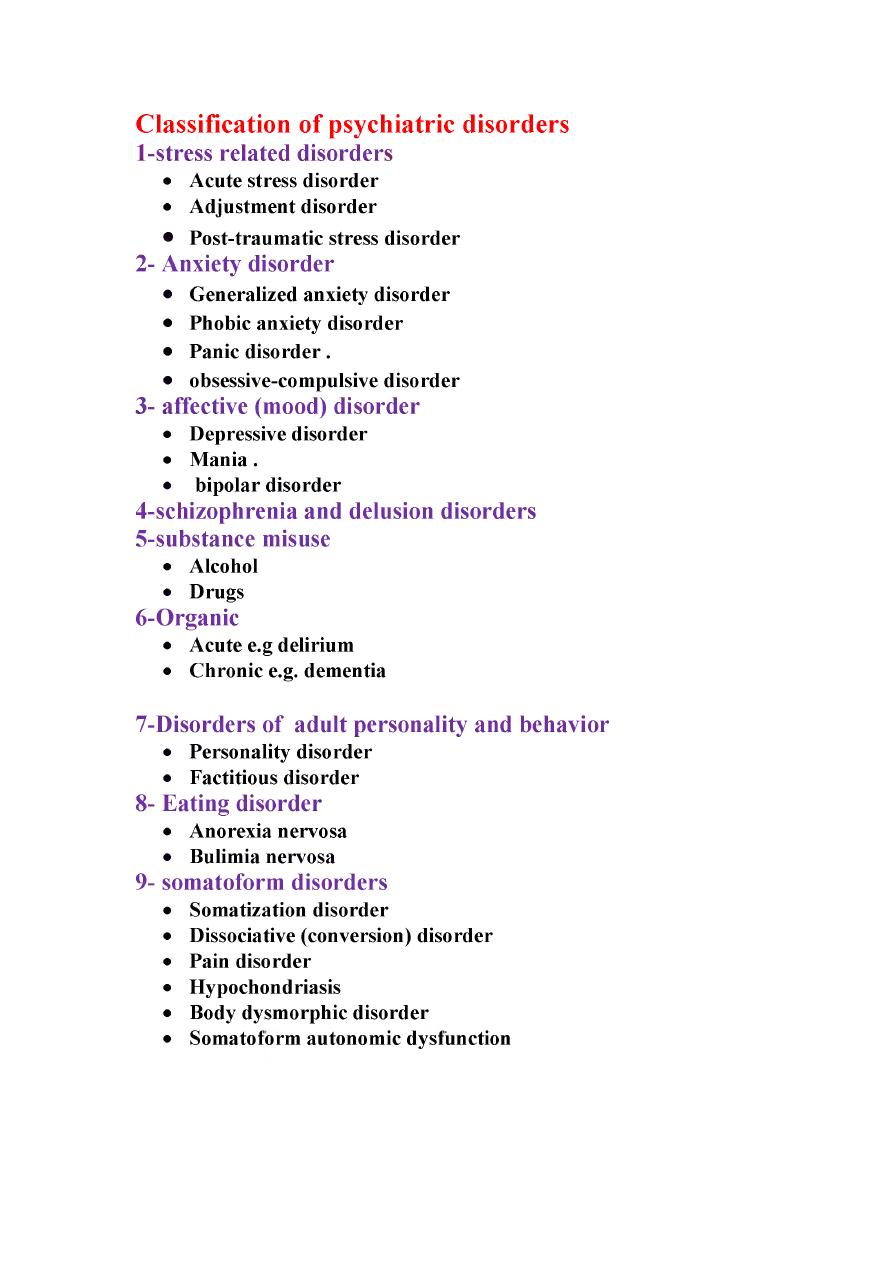
Classification of psychiatric disorders
1- stress related disorders
• Acute stress disorder
• Adjustment disorder
• Post-traumatic stress disorder
2- Anxiety disorder
• Generalized anxiety disorder
• Phobic anxiety disorder
• Panic disorder .
• obsessive-compulsive disorder
3- affective (mood) disorder
• Depressive disorder
• Mania .
• bipolar disorder
4- schizophrenia and delusion disorders
5- substance misuse
• Alcohol
• Drugs
6- Organic
• Acute e.g delirium
• Chronic e.g. dementia
7- Disorders of adult personality and behavior
• Personality disorder
• Factitious disorder
8- Eating disorder
• Anorexia nervosa
• Bulimia nervosa
9- somatoform disorders
• Somatization disorder
• Dissociative (conversion) disorder
• Pain disorder
• Hypochondriasis
• Body dysmorphic disorder
• Somatoform autonomic dysfunction
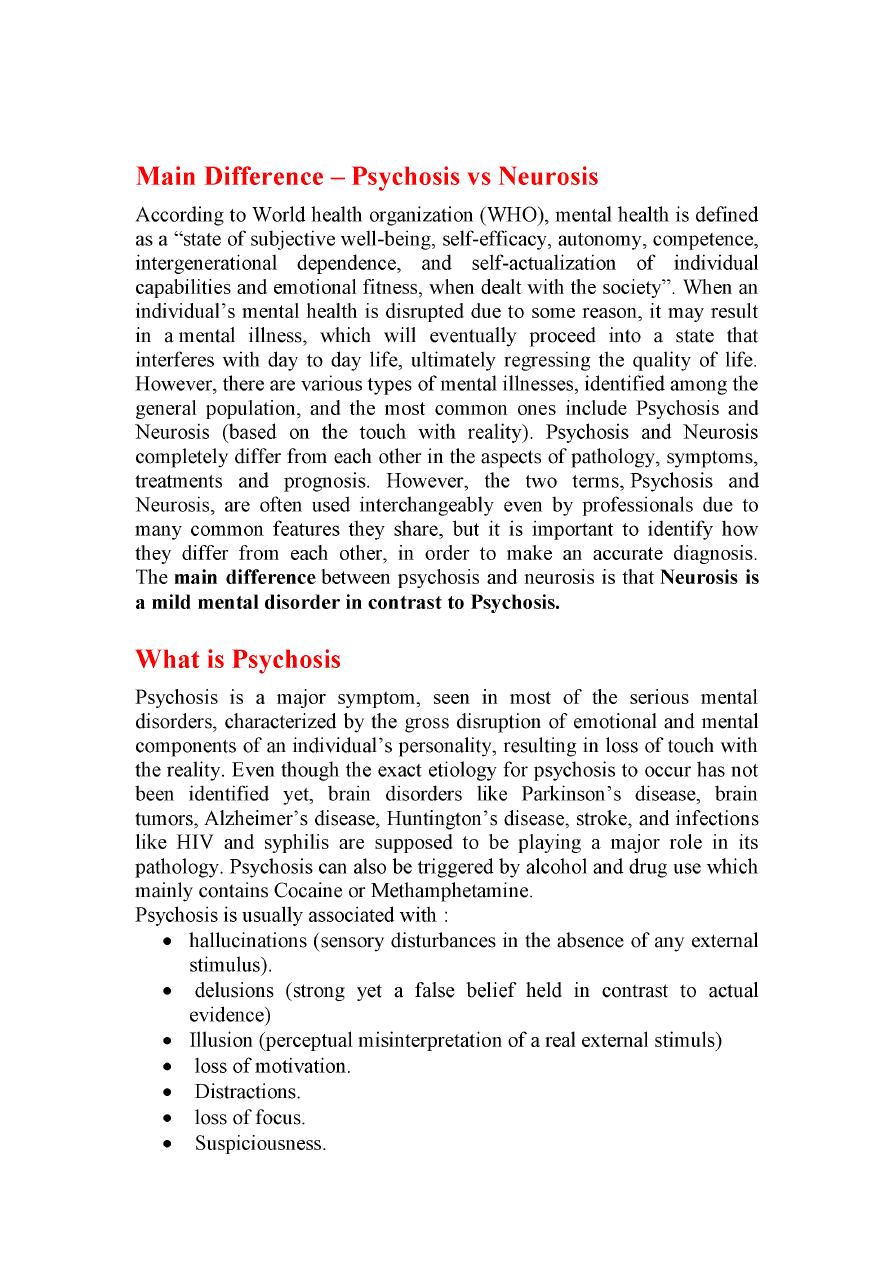
Main Difference - Psychosis vs Neurosis
According to World health organization (WHO), mental health is defined
as a “state of subjective well-being, self-efficacy, autonomy, competence,
intergenerational dependence, and self-actualization of individual
capabilities and emotional fitness, when dealt with the society”. When an
individual’s mental health is disrupted due to some reason, it may result
in a mental illness, which will eventually proceed into a state that
interferes with day to day life, ultimately regressing the quality of life.
However, there are various types of mental illnesses, identified among the
general population, and the most common ones include Psychosis and
Neurosis (based on the touch with reality). Psychosis and Neurosis
completely differ from each other in the aspects of pathology, symptoms,
treatments and prognosis. However, the two terms, Psychosis and
Neurosis, are often used interchangeably even by professionals due to
many common features they share, but it is important to identify how
they differ from each other, in order to make an accurate diagnosis.
The main difference between psychosis and neurosis is that Neurosis is
a mild mental disorder in contrast to Psychosis.
What is Psychosis
Psychosis is a major symptom, seen in most of the serious mental
disorders, characterized by the gross disruption of emotional and mental
components of an individual’s personality, resulting in loss of touch with
the reality. Even though the exact etiology for psychosis to occur has not
been identified yet, brain disorders like Parkinson’s disease, brain
tumors, Alzheimer’s disease, Huntington’s disease, stroke, and infections
like HIV and syphilis are supposed to be playing a major role in its
pathology. Psychosis can also be triggered by alcohol and drug use which
mainly contains Cocaine or Methamphetamine.
Psychosis is usually associated with :
• hallucinations (sensory disturbances in the absence of any external
stimulus).
• delusions (strong yet a false belief held in contrast to actual
evidence)
• Illusion (perceptual misinterpretation of a real external stimuls)
• loss of motivation.
• Distractions.
• loss of focus.
•
Suspiciousness.
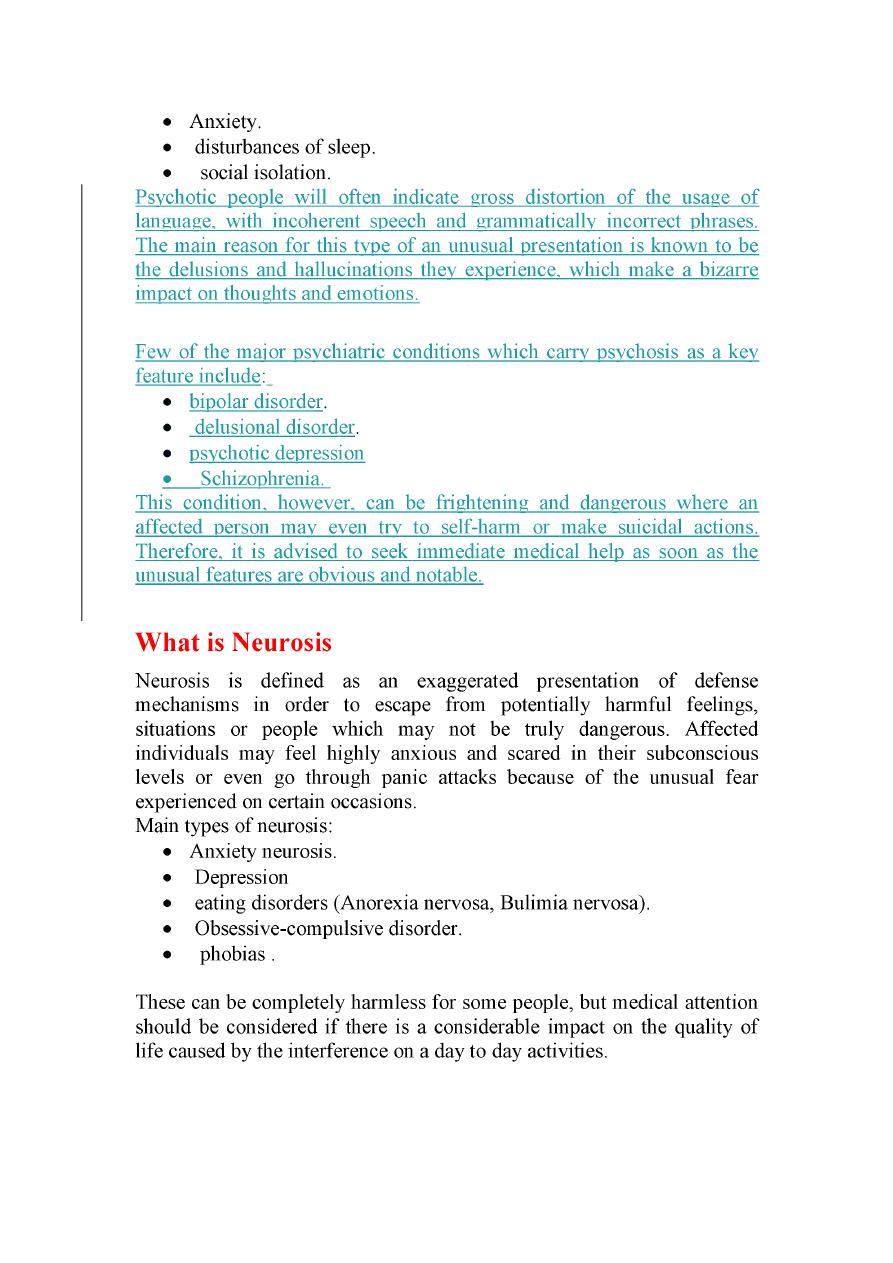
• Anxiety.
• disturbances of sleep.
•
social isolation.
Psychotic people will often indicate gross distortion of the usage of
language, with incoherent speech and grammatically incorrect phrases.
The main reason for this type of an unusual presentation is known to be
the delusions and hallucinations they experience, which make a bizarre
impact on thoughts and emotions.
Few of the major psychiatric conditions which carry psychosis as a key
feature include:
• bipolar disorder.
• delusional disorder.
• psychotic depression
•
This condition, however, can be frightening and dangerous where an
affected person may even try to self-harm or make suicidal actions.
Therefore, it is advised to seek immediate medical help as soon as the
unusual features are obvious and notable.
What is Neurosis
Neurosis is defined as an exaggerated presentation of defense
mechanisms in order to escape from potentially harmful feelings,
situations or people which may not be truly dangerous. Affected
individuals may feel highly anxious and scared in their subconscious
levels or even go through panic attacks because of the unusual fear
experienced on certain occasions.
Main types of neurosis:
• Anxiety neurosis.
• Depression
• eating disorders (Anorexia nervosa, Bulimia nervosa).
• Obsessive-compulsive disorder.
•
phobias .
These can be completely harmless for some people, but medical attention
should be considered if there is a considerable impact on the quality of
life caused by the interference on a day to day activities.
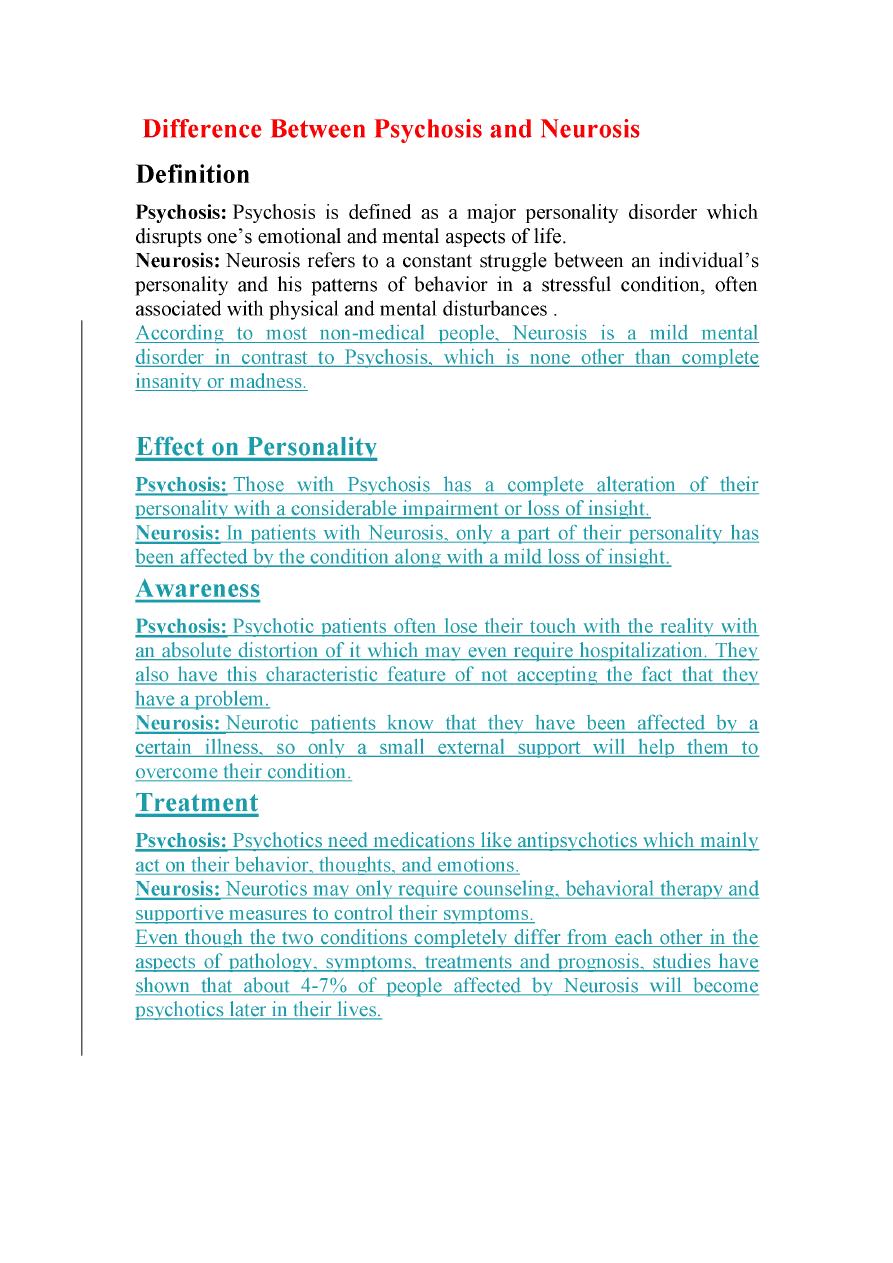
Difference Between Psychosis and Neurosis
Definition
Psychosis: Psychosis is defined as a major personality disorder which
disrupts one’s emotional and mental aspects of life.
Neurosis: Neurosis refers to a constant struggle between an individual’s
personality and his patterns of behavior in a stressful condition, often
associated with physical and mental disturbances .
According to most non-medical people, Neurosis is a mild mental
disorder in contrast to Psychosis, which is none other than complete
insanity or madness.
Effect on Personality
Psychosis: Those with Psychosis has a complete alteration of their
personality with a considerable impairment or loss of insight.
Neurosis: In patients with Neurosis, only a part of their personality has
been affected by the condition along with a mild loss of insight.
Awareness
Psychosis: Psychotic patients often lose their touch with the reality with
an absolute distortion of it which may even require hospitalization. They
also have this characteristic feature of not accepting the fact that they
have a problem.
Neurosis: Neurotic patients know that they have been affected by a
certain illness, so only a small external support will help them to
overcome their condition.
Treatment
Psychosis: Psychotics need medications like antipsychotics which mainly
act on their behavior, thoughts, and emotions.
Neurosis: Neurotics may only require counseling, behavioral therapy and
supportive measures to control their symptoms.
Even though the two conditions completely differ from each other in the
aspects of pathology, symptoms, treatments and prognosis, studies have
shown that about 4-7% of people affected by Neurosis will become
psychotics later in their lives.
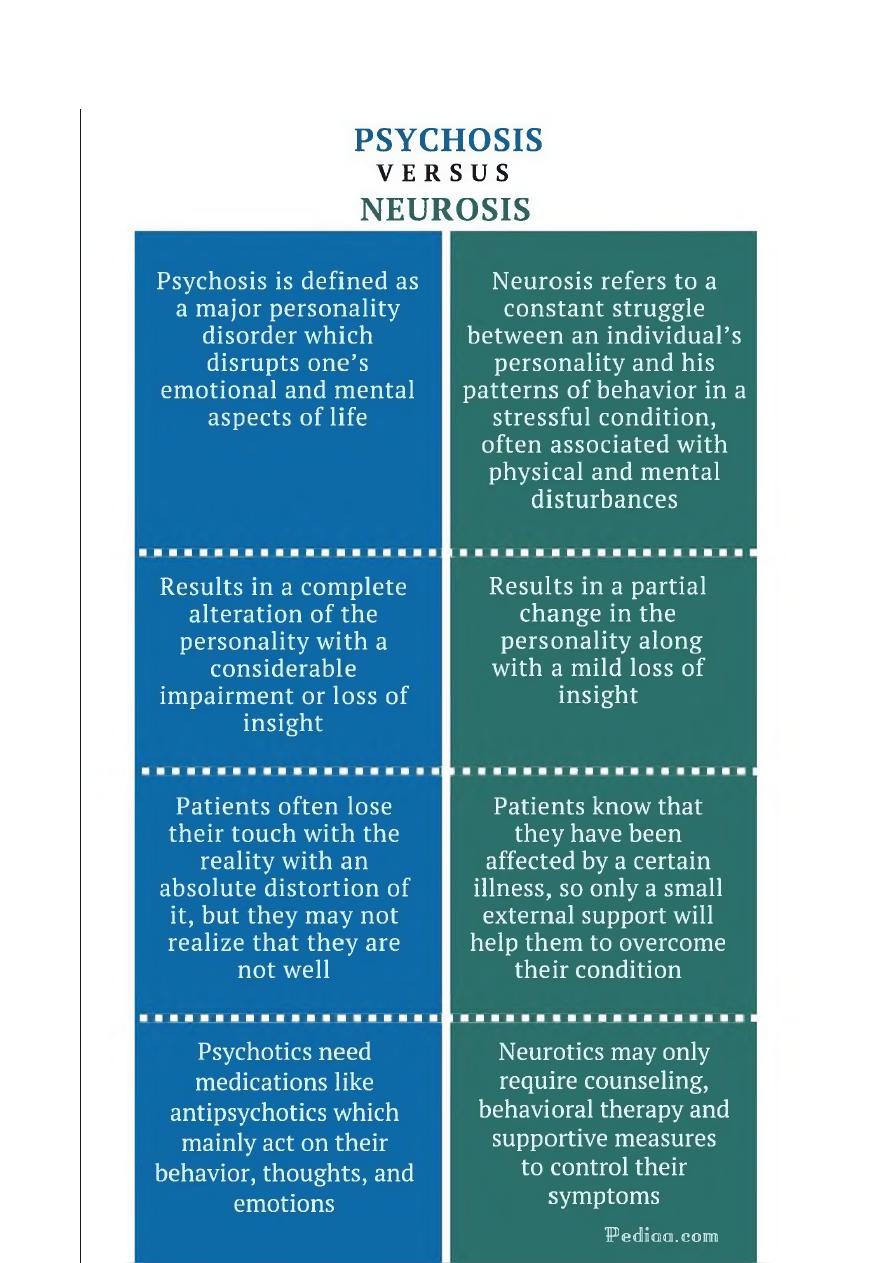
PSYCHOSIS
V E R S U S
NEUROSIS
P s y c h o s i s is d e f i n e d a s
a m a jo r p e r s o n a l i t y
d i s o r d e r w h ic h
d i s r u p t s o n e ’s
e m o t i o n a l a n d m e n t a l
a s p e c t s o f lif e
N e u r o s i s r e f e r s t o a
c o n s t a n t s t r u g g l e
b e t w e e n a n i n d i v i d u a l ’s
p e r s o n a l i t y a n d h is
p a t t e r n s o f b e h a v i o r in a
s t r e s s f u l c o n d i t i o n ,
o f t e n a s s o c i a t e d w i t h
p h y s i c a l a n d m e n t a l
d i s t u r b a n c e s
R e s u lt s in a c o m p l e t e
a l t e r a t i o n o f t h e
p e r s o n a l i t y w i t h a
c o n s i d e r a b l e
i m p a i r m e n t o r lo s s o f
i n s i g h t
R e s u l t s in a p a r t i a l
c h a n g e in t h e
p e r s o n a l i t y a l o n g
w i t h a m ild lo s s o f
i n s i g h t
P a t i e n t s o f t e n lo s e
t h e i r t o u c h w i t h t h e
r e a l i t y w i t h a n
a b s o l u t e d i s t o r t i o n o f
it, b u t t h e y m a y n o t
r e a l i z e t h a t t h e y a r e
n o t w e ll
P a t i e n t s k n o w t h a t
t h e y h a v e b e e n
a f f e c t e d b y a c e r t a in
illn e s s , so o n ly a s m a ll
e x t e r n a l s u p p o r t w ill
h e lp t h e m to o v e r c o m e
t h e i r c o n d i tio n
P s y c h o tic s n e e d
m e d ic a tio n s lik e
a n tip s y c h o tic s w h ic h
m a in ly a c t o n t h e i r
b e h a v io r , t h o u g h t s , a n d
e m o tio n s
N e u r o tic s m a y o n ly
r e q u ir e c o u n s e lin g ,
b e h a v io r a l th e r a p y a n d
s u p p o r tiv e m e a s u r e s
to c o n tr o l t h e i r
s y m p to m s
P e d io a .c o n m
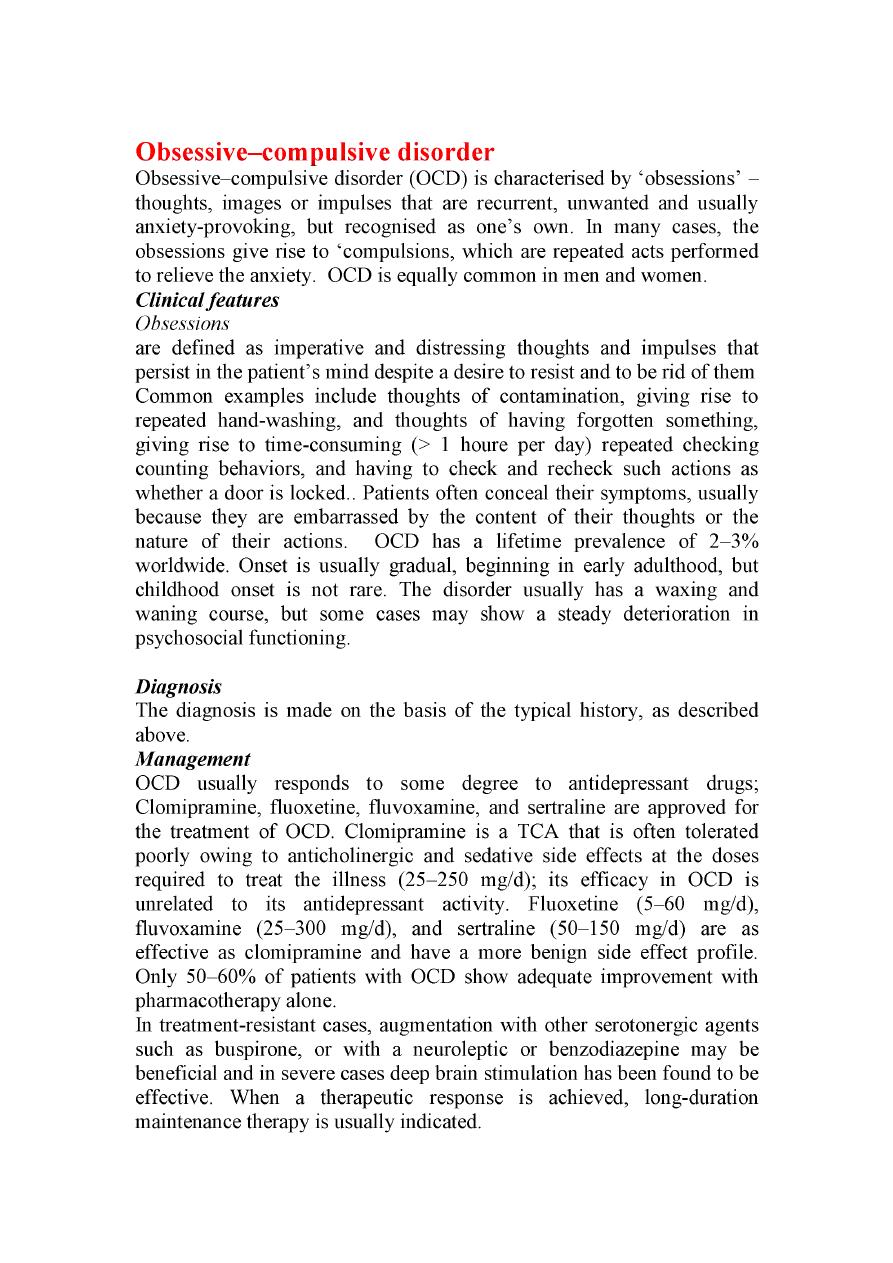
Obsessive-compulsive disorder
Obsessive-compulsive disorder (OCD) is characterised by ‘obsessions’ -
thoughts, images or impulses that are recurrent, unwanted and usually
anxiety-provoking, but recognised as one’s own. In many cases, the
obsessions give rise to ‘compulsions, which are repeated acts performed
to relieve the anxiety. OCD is equally common in men and women.
Clinical features
Obsessions
are defined as imperative and distressing thoughts and impulses that
persist in the patient’s mind despite a desire to resist and to be rid of them
Common examples include thoughts of contamination, giving rise to
repeated hand-washing, and thoughts of having forgotten something,
giving rise to time-consuming (> 1 houre per day) repeated checking
counting behaviors, and having to check and recheck such actions as
whether a door is locked.. Patients often conceal their symptoms, usually
because they are embarrassed by the content of their thoughts or the
nature of their actions.
OCD has a lifetime prevalence of 2-3%
worldwide. Onset is usually gradual, beginning in early adulthood, but
childhood onset is not rare. The disorder usually has a waxing and
waning course, but some cases may show a steady deterioration in
psychosocial functioning.
Diagnosis
The diagnosis is made on the basis of the typical history, as described
above.
Management
OCD usually responds to some degree to antidepressant drugs;
Clomipramine, fluoxetine, fluvoxamine, and sertraline are approved for
the treatment of OCD. Clomipramine is a TCA that is often tolerated
poorly owing to anticholinergic and sedative side effects at the doses
required to treat the illness (25-250 mg/d); its efficacy in OCD is
unrelated to its antidepressant activity. Fluoxetine (5-60 mg/d),
fluvoxamine (25-300 mg/d), and sertraline (50-150 mg/d) are as
effective as clomipramine and have a more benign side effect profile.
Only 50-60% of patients with OCD show adequate improvement with
pharmacotherapy alone.
In treatment-resistant cases, augmentation with other serotonergic agents
such as buspirone, or with a neuroleptic or benzodiazepine may be
beneficial and in severe cases deep brain stimulation has been found to be
effective. When a therapeutic response is achieved, long-duration
maintenance therapy is usually indicated.
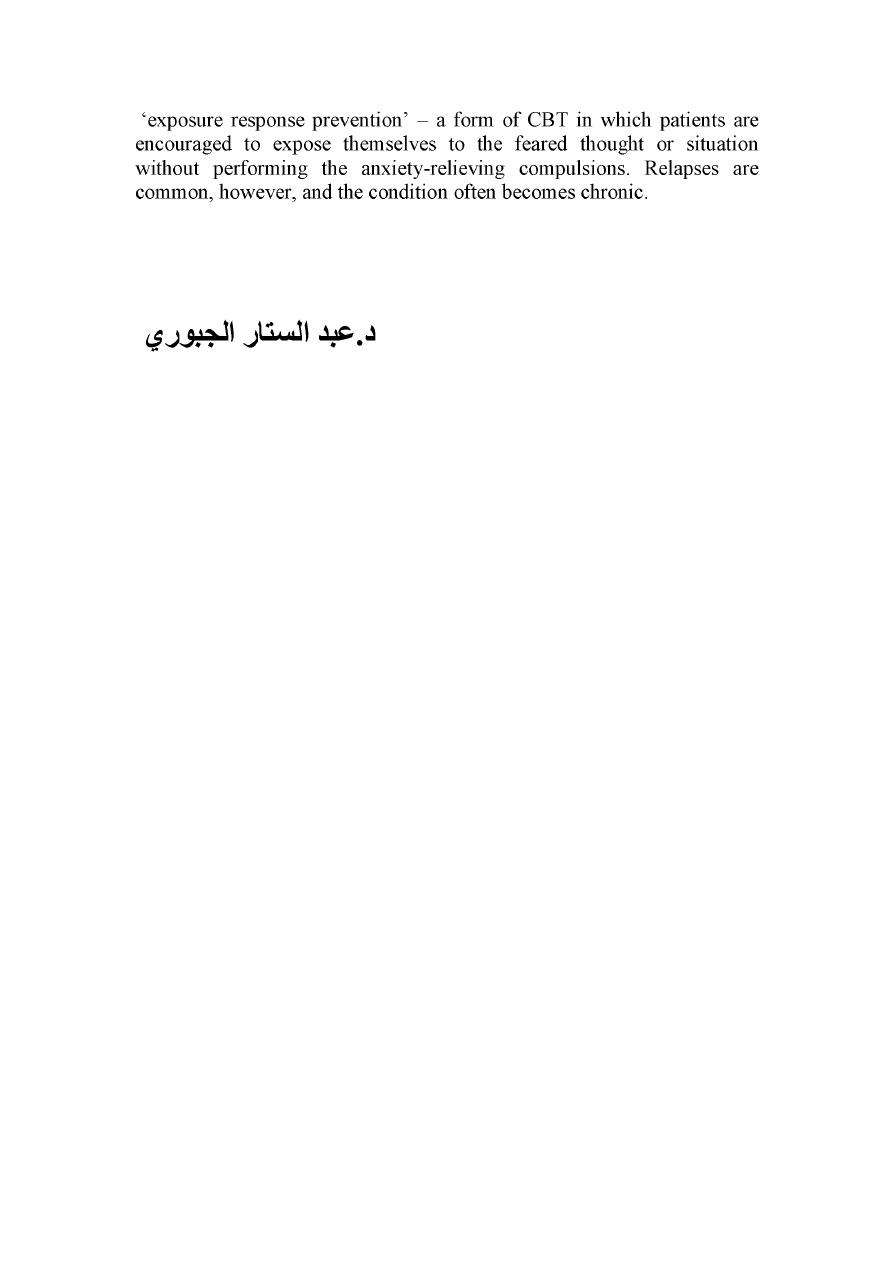
‘exposure response prevention’ - a form of CBT in which patients are
encouraged to expose themselves to the feared thought or situation
without performing the anxiety-relieving compulsions. Relapses are
common, however, and the condition often becomes chronic.
